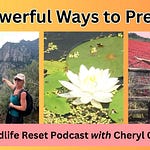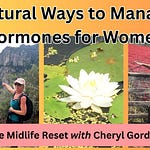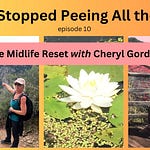What do you do when you’ve always been active—skiing, skating, cycling, playing racquet sports well into your 70s—and suddenly, your body says no more?
Let me tell you about June. By her 70th birthday, chronic pain had crept in. Nights were sleepless. The joy of walking had vanished. She was picturing a future where she was trapped in a chair, watching life go by.
Sound familiar?
If you’ve ever felt betrayed by your body… if you’ve tried everything from physio to pills, and still feel stuck… this episode is for you.
Welcome to the Midlife Reset Podcast episode #17. I’m Cheryl Gordon, yoga therapist. I educate midlife women on losing weight, feeling stronger and sleeping better using the tools of yoga and mindfulness.
Today, I’m sharing how a simple, time-tested movement practice called the Joint Freeing Series helped June regain her mobility, ease her pain, and even improve her sleep. No magic. No hype. Just ancient wisdom adapted for modern, aching joints—and a reminder that healing is possible, even when it feels out of reach.
Let’s dive in.
By the time June came to yoga therapy, she had tried most other pain remedies and was understandably frustrated. Most people who come into therapy have tried many things and are fed up.
The first order of business, after getting to know each other, was to give June something hopeful on which to focus. She pictured herself chair bound and her life closing in on her. The exercises that she had received from her chiropractor and physiotherapist weren’t holding her attention – so they weren’t getting done. June needed something easy on the joints but interesting enough to motivate her to practice every day. She needed a routine that would help her deal with all the side effects of that arthritic hip.
Chronic joint pain is about more than a knee or hip. As you can imagine in June’s case, her worries and frustrations about her narrowing activity opportunities were causing as much pain as the actual arthritis.
Having pain causes us to adjust our socializing so we can become isolated and at risk for depression. You never know if you’re going to have a good day or a bad day. You don’t want to slow the others down so you make excuses. Gradually June’s social circle was narrowing. Even during family gatherings, she had to stay parked on the couch while the younger ones played soccer or headed to the basement rec room for video games. Not her usual adventurous personality.
Having pain and getting yet another round of tests makes us feel like we are at the mercy of others, holding no power ourselves to heal. We can feel reduced to a series of numbers and statistics. Each specialist knows his or her stuff inside and out but they don’t see us in our wholeness. They treat one aspect of our pain but are often in conflict with another specialist. At the very least, there is often confusion about who is doing what. I always tell my clients… if you go to a surgeon, you will get a surgical solution. If you go to your family doctor, you will get a pharmaceutical solution. This is how they are trained. They are doing their jobs.
Having pain can create a feeling of hopelessness that causes other areas of self-care to fall away. It’s very difficult to focus on a healthy diet if it hurts too much to stand to cook or grocery shop, for example. Feeling left out, being reduced to numbers on tests, having disturbed sleep… this all leads to a general malaise that we often diagnose as depression. But it’s not about chemical imbalances in the brain but more situational.
Client after client, time and time again, I find that the Joint Freeing Series is just the ticket. This simple series of uni-joint movements done in a specific order helps in so many ways.
The movements distribute lubrication in the joint, helping to reduce inflammatory compounds and to bring healing fluids to the tissues. Wherever there is circulation, there is healing. The instinct might be to not move… it could make it worse. But gentle, rhythmic movement pumps those healing fluids through the joint. In the Joint Freeing Series, movements are done without weight bearing. You only move the joint as much as you can with comfort. You might feel stretch or a sensation of change, but no pain.
The movements stretch tight places and strengthen weaker places gently. It is not a good plan to stretch an inflamed tissue. Imagine you have a cut on your arm. The two pieces of skin are trying to knit together. It is red, inflamed, maybe tender to touch. And now you pull the two apart and reopen the wound. What???? That would be nuts right? It was just healing! But that’s what you are doing to the soft tissue when you aggressively stretch a sore joint. And strengthening the opposing movements, or muscle groups, is very helpful to take pressure off the movements that are causing soreness in the joints. For example, in the hip…. Lifting the knee up to climb stairs can be painful. That’s flexion of the hip. Many times in my experience if we work on gentle strengthening of the opposing muscle group… the extensors of the hip joint… it helps to balance out the function of the hip and some pain is alleviated.
The movements remind the brain how to fire muscles in an efficient and safe way. Muscles don’t move by themselves. The brain tells them when to fire up. And the movement map in the brain is quite changeable and fluid. When we use a joint in a habitual way… and maybe that led to some imbalance that is now causing pain… we need to address re-programming the brain. This is called neuro-muscular reprogramming. To be successful, movements need to be repeated often in the corrected pattern with a calm frame of mind. The Joint Freeing Series does just this. Part of the magic is the focus on breath and slow pace. This keeps the nervous system in a learning mode.
The breath pattern is soothing to the nervous system and can alleviate our impression of pain. So the breathing in the Joint Freeing Series not only keeps us in that learning state of mind but also changes, literally changes, the way the brain is receiving sensory signals from your body. The classic story my teacher used to tell was about the paper cut at work. It always hurt way more than if the same injury occurred on Sunday afternoon when you were reading the comics section of the paper. Mindset deeply affects how we receive signals from our environment.
The practice is ordered in such a way as to engage the brain, like a meditation, which helps to wire new ways of thinking less focused on the pain. In June’s case, her worries about becoming wheel chair bound or living in her own home much longer were causing sleepless nights. Practising meditation, even moving forms like the Joint Freeing Series, can help anchor our minds in the present moment. This lifts us out of the worry loop. What a relief! Even if it’s just for a few minutes. Remember… the brain is very fluid and changeable. When we practice worry, we get really good at it. When we practice focusing on pure patterns of movement, we get better and better at that. What a pleasant surprise benefit for June… her sleeping improved!
You know, we often look for complicated solutions to our problems because our problems feel so overwhelming. But honestly… in so many situations, the simple approach is the most accessible and effective. The Joint Freeing Series is a prime example. The movements are simple. Each joint is moved in a single range on its own. We call this ‘uni-joint’ movements. You can really concentrate and feel each sensation independently.
What about June? We had about six sessions together and she made real progress. It was amazing to see how her whole person started feeling lighter. I got a note from her about a year after. She had gone for the hip replacement. She used the focus on breathing to manage all the pain and stress that goes with joint replacement. Her team was impressed how quickly she recovered. For anyone who has had joint replacement, you know that the alien part in your body is disconcerting. There are layers of trauma to process. June used her skills gained in yoga therapy to work through all of that.
I do recommend a specific protocol for hip and knee pain called “Release and Strengthen”. I’ll put a link to that in the show notes. June took advantage of the convenience of the home videos instead of booking private sessions when she was going through all this.
If you want to learn how to use this program for “prehab”, check out episode 15 of this podcast. I cover all the reasons why preparing for joint replacement is just as important as recovery.
Do you have to be in desperate straights to try the Joint Freeing Series? Hell, no! I use a version of this protocol every day! I’m a huge believer in keeping that pure movement pattern fresh in my brain. I’ll do the standing version before my sun salutes in the morning. I’ll do the supine version in bed to relax before sleep. I’ll base a whole yoga class on the classic version because I know my students are benefiting from attention to each joint.
Can you imagine not starting the Joint Freeing Series today? I have been doing a big sales pitch right? But I believe so strongly in the importance of this practice, I give the program away for free. There is absolutely no charge. I think every body NEEDS to stay movement oriented. And this protocol is ancient, time tested and I’ve adapted it for most needs.
Use the link in the show notes to access the Joint Freeing Series now. It is free. There are four videos that demonstrate a standing version, a chair based version (no getting up and down from the floor), a supine version and the classic version that does involve some up and down. It takes about 15 - 20 minutes the first few times, but you’ll master the routine quickly. I can move through it in 5 minutes if I want to move on to another activity.













Share this post